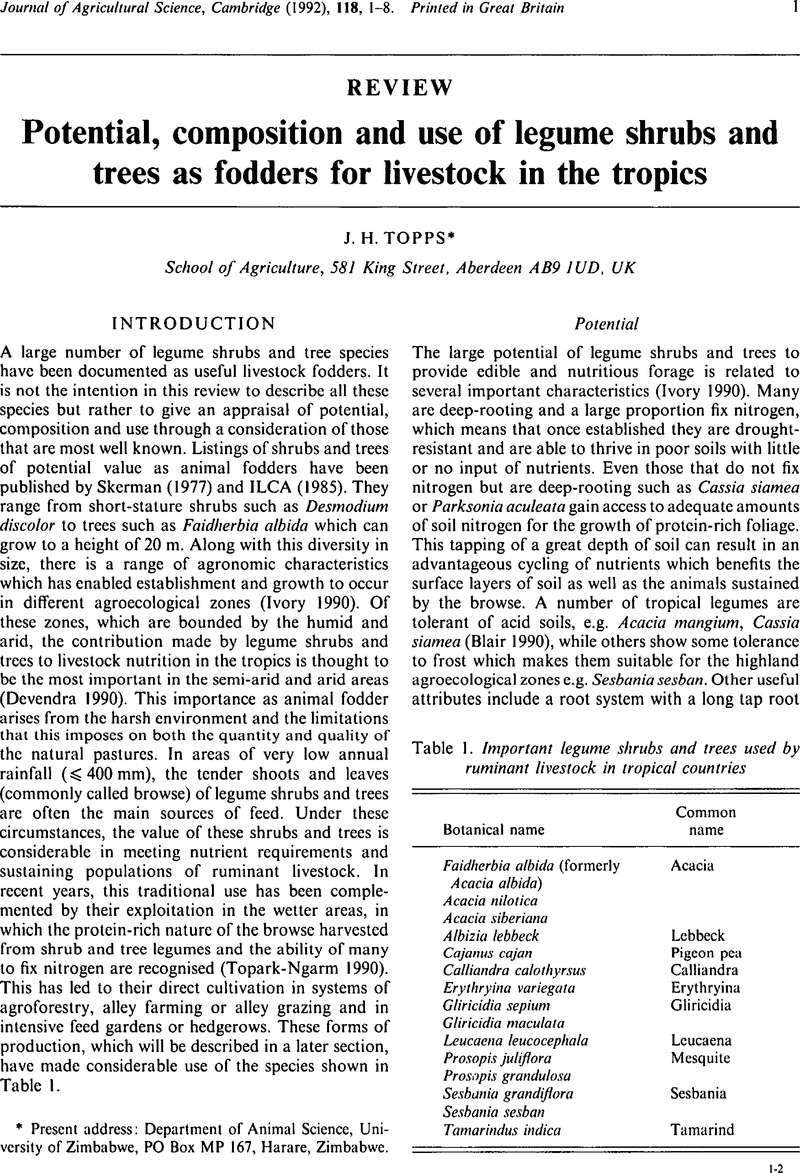Crossref Citations
This article has been cited by the following publications. This list is generated based on data provided by Crossref.
Acamovic, T.
Hare, Justine
and
Topps, J.H.
1993.
The Nutritive Value of Some Tropical Forage Legumes from Zimbabwe..
Proceedings of the British Society of Animal Production (1972),
Vol. 1993,
Issue. ,
p.
203.
Nsahlai, I V
Siaw, D E K A
and
Umunna, N N
1995.
Inter‐relationships between chemical constituents, rumen dry matter and nitrogen degradability in fresh leaves of multipurpose trees.
Journal of the Science of Food and Agriculture,
Vol. 69,
Issue. 2,
p.
235.
Degen, A Allan
Becker, Klaus
Makkar, Harinder P S
and
Borowy, Norbert
1995.
Acacia saligna as a fodder tree for desert livestock and the interaction of its tannins with fibre fractions.
Journal of the Science of Food and Agriculture,
Vol. 68,
Issue. 1,
p.
65.
Odee, D. W.
Sutherland, J. M.
Kimiti, J. M.
and
Sprent, J. I.
1995.
Natural rhizobial populations and nodulation status of woody legumes growing in diverse Kenyan conditions.
Plant and Soil,
Vol. 173,
Issue. 2,
p.
211.
Smith, J. W.
Larbi, A.
Jabbar, M. A.
and
Akinlade, J.
1995.
Rumen degradation in sheep, goats and cattle and voluntary intake by sheep of four browse species.
Agroforestry Systems,
Vol. 32,
Issue. 3,
p.
277.
Bonsi, M.L.K.
Osuji, P.O.
and
Tuah, A.K.
1995.
Effect of supplementing teff straw with different levels of leucaena or sesbania leaves on the degradabilities of teff straw, sesbania, leucaena, tagasaste and vernonia and on certain rumen and blood metabolites in Ethiopian Menz sheep.
Animal Feed Science and Technology,
Vol. 52,
Issue. 1-2,
p.
101.
Silanikove, N.
Gilboa, N.
Perevolotsky, A.
and
Nitsan, Z.
1996.
Goats fed tannin-containing leaves do not exhibit toxic syndromes.
Small Ruminant Research,
Vol. 21,
Issue. 3,
p.
195.
Larbi, A.
Kurdi, O. I.
Said, A. N.
and
Hanson, J.
1996.
Classification of Erythrina provenances by rumen degradation characteristics of dry matter and nitrogen.
Agroforestry Systems,
Vol. 33,
Issue. 2,
p.
153.
Abdulrazak, S. A.
Muinga, R. W.
Thorpe, W.
and
Ørskov, E. R.
1996.
The effects of supplementation with Gliricidia sepium or Leucaena leucocephala forage on intake, digestion and live-weight gains of Bos taurus × Bos indicus steers offered napier grass.
Animal Science,
Vol. 63,
Issue. 3,
p.
381.
Silanikove, N.
Gilboa, N.
Nir, I.
Perevolotsky, A.
and
Nitsan, Z.
1996.
Effect of a Daily Supplementation of Polyethylene Glycol on Intake and Digestion of Tannin-Containing Leaves (Quercus calliprinos, Pistacia lentiscus, and Ceratonia siliqua) by Goats.
Journal of Agricultural and Food Chemistry,
Vol. 44,
Issue. 1,
p.
199.
Nsahlai, I.V.
and
Umunna, N.N.
1996.
Sesbania and lablab supplementation of oat hay basal diet fed to sheep with or without maize grain.
Animal Feed Science and Technology,
Vol. 61,
Issue. 1-4,
p.
275.
Salawu, M.B.
Acamovic, T.
Stewart, C.S.
Hovell, F.D.DeB.
and
McKay, I.
1997.
Assessment of the nutritive value of Calliandra calothyrsus: in sacco degradation and in vitro gas production in the presence of Quebracho tannins with or without Browse Plus.
Animal Feed Science and Technology,
Vol. 69,
Issue. 1-3,
p.
219.
Degen, A. A.
Blanke, A.
Becker, K.
Kam, M.
Benjamin, R. W.
and
Makkar, H. P. S.
1997.
The nutritive value of Acacia saligna and Acacia salicina for goats and sheep.
Animal Science,
Vol. 64,
Issue. 2,
p.
253.
Larbi, A.
Smith, J.W.
Raji, A.M.
Kurdi, I.O.
Adekunle, I.O.
and
Ladipo, D.O.
1997.
Seasonal dynamics in dry matter degradation of browse in cattle, sheep and goats.
Small Ruminant Research,
Vol. 25,
Issue. 2,
p.
129.
Kaitho, R.J.
Umunna, N.N.
Nsahlai, I.V.
Tamminga, S.
van Bruchem, J.
and
Hanson, J.
1997.
Palatability of wilted and dried multipurpose tree species fed to sheep and goats.
Animal Feed Science and Technology,
Vol. 65,
Issue. 1-4,
p.
151.
Larbi, A
Smith, J.W
Kurdi, I.O
Adekunle, I.O
Raji, A.M
and
Ladipo, D.O
1998.
Chemical composition, rumen degradation, and gas production characteristics of some multipurpose fodder trees and shrubs during wet and dry seasons in the humid tropics.
Animal Feed Science and Technology,
Vol. 72,
Issue. 1-2,
p.
81.
Khandaker, Z.H.
Steingass, H.
and
Drochner, W.
1998.
Supplementation of wheat straw with sesbania on voluntary intake, digestibility and ruminal fermentation in sheep.
Small Ruminant Research,
Vol. 28,
Issue. 1,
p.
23.
Wood, C.D
Stewart, J.L
and
Vargas, J.E
1998.
Genetic variation in the nutritive value of Gliricidia sepium..
Animal Feed Science and Technology,
Vol. 75,
Issue. 2,
p.
125.
Karachi, M
1998.
Variation in the nutritional value of leaf and stem fractions of nineteen leucaena lines.
Animal Feed Science and Technology,
Vol. 70,
Issue. 4,
p.
305.
Degen, A. A.
Mishorr, T.
Makkar, H. P. S.
Kam, M.
Benjamin, R. W.
Becker, K.
and
Schwartz, H. J.
1998.
Effect of Acacia saligna with and without administration of polyethylene glycol on dietary intake in desert sheep.
Animal Science,
Vol. 67,
Issue. 3,
p.
491.





